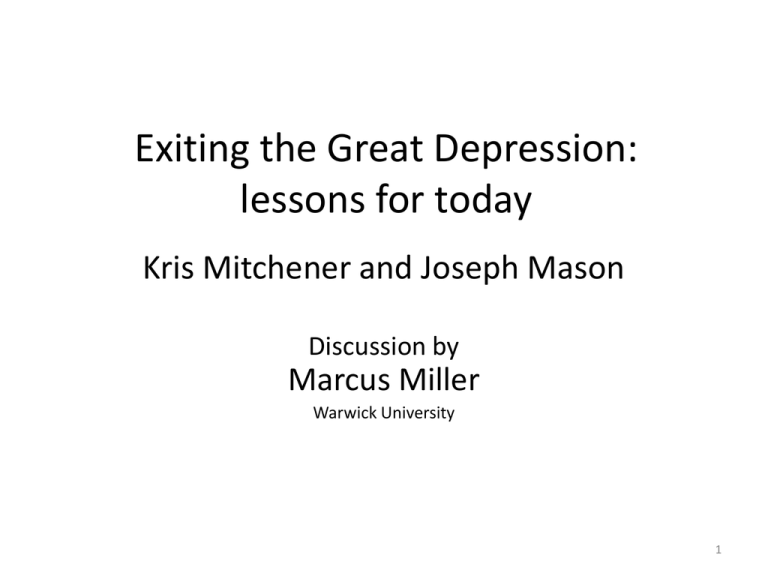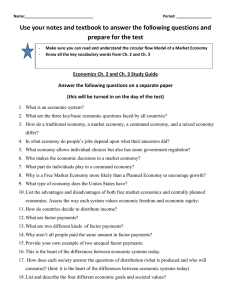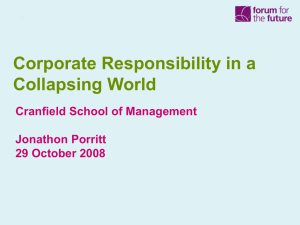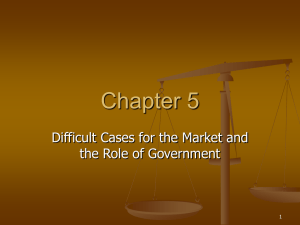Exiting the Great Depression: lessons for today Kris Mitchener and Joseph Mason
advertisement

Exiting the Great Depression: lessons for today Kris Mitchener and Joseph Mason Discussion by Marcus Miller Warwick University 1 Discussant’s comments What I liked M and M’s outline of fascinating features like • Extent of bank recapitalisation through RFC striking • Anti firesales activity of Deposit Liquidation Board Their flagging of key issues like • Tackling asymmetric information via certification, FDIC, etc. • Political problems of reversing crisis induced institutional support 2 What I missed • Didn’t get their 3 R’s! How about• Rescuing the system, too little too late in 1930s • Regulating banks: in 1930s prudential regulation crucial complement to deposit insurance. • Reform the system: in 1930s this included Glass-Steagall, SEC, Chapter 11 Bankruptcy I will use these as headings for comments to follow 3 1. Rescue (Image of the $1 trillion liquidity support by FRBNY) 4 ‘The Great Escape’ • What would have happened to the US economy if the Federal Reserve had not intervened by spending 7% of US GDP buying illiquid assets in 2008/9? • The FRBNY have modelled the effect of a liquidity crunch without such intervention; and then with the liquidity injection of $1 trillion • Results can be shown as: 5 Effect of a liquidity shock in US that lasts 10 quarters, Del Negro et al. (2009) Solid blue : no intervention. Dashed blue: $1 trillion liquidity injection. The Counterfactual 40 % fall of Investment Output falling initially by 25% Then down to 30% The capital stock falling by 1% a quarter until liquidity is restored 6 Help from Central Banks - since Aug ‘07 7 Plus support from Government =3/4 GDP! • • • United Kingdom Jan. 2007 Latest United States Jan.207 Latest Government support £ trillions • • Guarantees of financial institutions’ liabilities • • Insurance of financial assets – 0.46 Capital injections to banks and special purpose vehicles – • • – Increase in public sector support $ trillions 0.37 – – 0.06 1.26 3.74 – – 2.08 0.70 10.44 (including CB assistance) • Percentage of GDP – 88% – 73% 8 2. Regulation • Crisis has revealed profound problems of • asymmetric information • Financial externalities (fire sales, network effects) • Market concentration These lie outside the competitive paradigm of economics, so tackling them will require thinking outside the box 9 Challenges to the market paradigm Competitive Market paradigm Missing information; missing Externalities, e.g. markets systemic risk Strategic Power Market collapse 10 ‘Greenspan defends position on free market’ Central Banking.com 6 Apr 2010 • Alan Greenspan, a former chairman of the Federal Reserve, has refuted claims that his comments on the recent failures in financial markets are in any way a repudiation of the laissez-faire view that markets can be trusted to police themselves. • "There is no alternative if you want to have economic growth, higher standards of living, in a democratic society, to have competitive markets," he said. 11 Externalities • Economists use the term ‘negative externality’ to refer to a side effect of economic activity that you don’t pay for. • One example is Global Warming: use of car has side effects on global carbon build-up - and some predicting Armageddon as a result. • Another example is atmospheric pollution. • We focus on ‘fire-sale’ and ‘network’ externalities. 12 Two Regulatory Responses: taxing externalities • Some advocate Pigovian taxation of externalities associated with HLIs ‘Highly Leveraged Institutions’* who generate externalities – e.g. by capital adequacy ratios and presumably liquidity ratios, Korinek (2009) and Haldane(2010) * inc banks, shadow banks and hedge funds who might get involved in ‘fire-sales’ 13 Key Problem: Tail risk within financial systems is endogenous and often unobserved • it is hazardous to believe there is a magic number for regulatory ratios sufficient to insure against tail risk in all states of the world. Because tail risk is created not endowed, calibrating a capital ratio for all seasons is likely to be, quite literally, pointless – whatever today’s optimal regulatory point, risk incentives mean that tomorrow’s is sure to be different. • A.G. Haldane ‘The $100b question’ 14 Prohibition • Andrew Haldane “The $100 b question”(2010) argues that: • Banks will always be able to move faster than the regulators , and avoid control by ‘regulatory arbitrage’. Look at the US shadow banking industry! • Hence the need for prohibition - to ban activities that threaten to generate negative externalities. • “Prohibition” may have a 1930s sound, and that’s right 15 US in 1930s: Glass-Steagall • Glass-Steagall : simple in objectives and execution. • Clear aim - shaped by an extreme tail event (the Great Depression) –was to avoid a repetition. • It sought to achieve this by acting directly on the structure of the financial system, quarantining commercial bank and brokering activities through red-line regulation. • Lasted over half a century without a significant systemic event in the US, until revoked in 1999 by Gramm-Leach-Bliley Act . And then….? 16 Average assets relative to GDP of US commercial banks Source: A.G. Haldane ‘The $100b question’ 0.012 percentage of Nominal GDP Average Assets per Commercial Bank as a 0.014 0.010 0.008 0.006 0.004 0.002 0.000 34 1 42 9 1 1938 0 8 6 5 5 6 4 1 1946 19 1954 19 1962 19 9 Year 1970 0 86 7 9 1 1978 1982 1 19 8 94 9 9 2 19 6 02 9 9 0 0 20 Average Asset Size of Commercial Banks scaled by Nominal GDP 17 Concentration of the US banking system Total assets of top 3 US banks (as % of total commercial banking sector assets) Source: A.G. Haldane ‘The $100b question’ 45.00 40.00 35.00 30.00 25.00 20.00 15.00 10.00 5.00 0.00 1935 1939 1943 1947 1951 1955 1959 1963 1967 1971 1975 1979 1983 1987 1991 1995 1999 2003 2007 18 3.Reform of structure • In a context of asymmetric information, HLI’s use the property rights of the capitalist system to generate profits which reflect transfers rather than value added. • Why not change property rights? E.g. • Volcker Rule to bring back Glass-Steagall • Investment banks to be partnerships again • Double liability for commercial bank shares? 19 Let me out of here! 20 What is not legally banned may be economically attractive (with moral issues left aside) Economic progress: two possibilities: •A: OK •B: PROBLEM Legally banned Morally unacceptable Is there not a risk that that well-heeled, politically savvy, financial institutions - with the best lawyers and least moral scruples - will stay ahead of legal and moral sanctions. 21 Postscript • ‘Wall Street titans still recklessly speculate with borrowed money. We cannot delay action any longer.’ (Barack Obama) • Goldman charged with fraud FT Headline - 17 April 2010 • ‘US authorities yesterday accused Goldman Sachs of securities fraud that caused investor losses of more than $1bn (£649m). 22 Competition between Cultures? • In Western, market-based culture, the limitations on property rights depends explicitly on legal sanctions • But these are failing to internalise externalities • In some Eastern cultures, the rule of law is not paramount; and, in any case, there may be other sanctions , e.g. shame, capital punishment. • So they may be better able to internalise externalities! *Dipak Lal Unintended Consequences, 23




